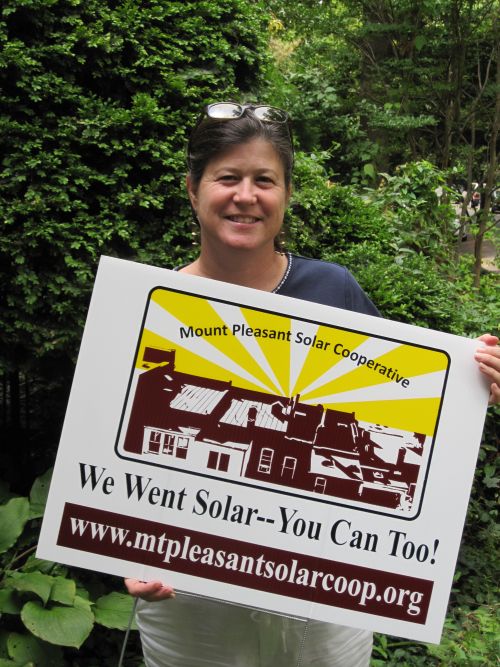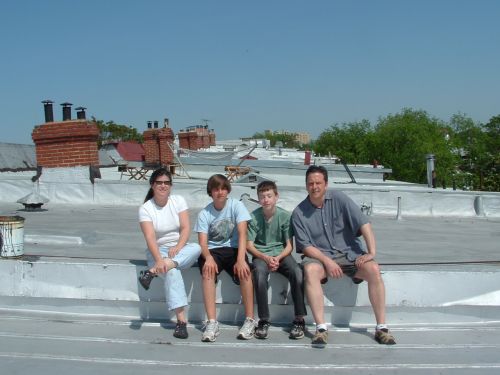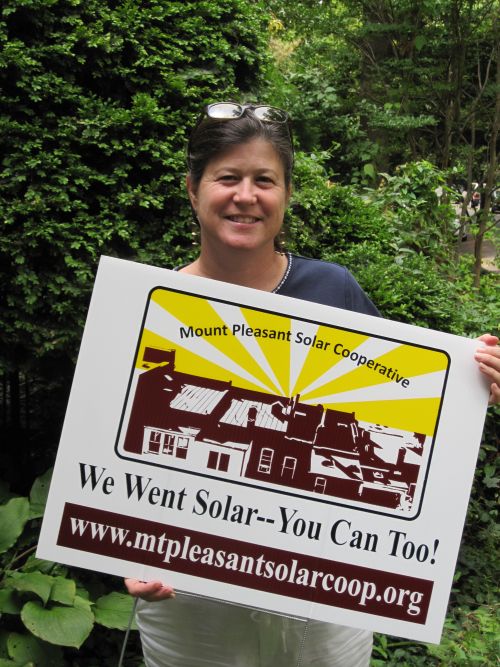This interview is part of a series on people who are making their communities smarter, greener places to live. Got a nomination? Leave it in the comments section or send it along to us.
 All signs point to solar for Schoolman and her neighbors.For a while, things were looking gloomy. The founders of Washington, D.C.’s Mount Pleasant Solar Cooperative had their hearts in the right place; they even had their paperwork in the right place. But they hit snag after snag as they tried to fulfill the dream of converting their neighborhood to solar power: Contractors who didn’t want to sell solar panels in bulk. Confusion over the role of the regional utility. And the inevitable red tape of local politics.
All signs point to solar for Schoolman and her neighbors.For a while, things were looking gloomy. The founders of Washington, D.C.’s Mount Pleasant Solar Cooperative had their hearts in the right place; they even had their paperwork in the right place. But they hit snag after snag as they tried to fulfill the dream of converting their neighborhood to solar power: Contractors who didn’t want to sell solar panels in bulk. Confusion over the role of the regional utility. And the inevitable red tape of local politics.
Eventually the group’s persistence paid off, and this month they’re celebrating their fiftieth neighborhood solar installation. We caught up with co-founder and president Anya Schoolman to find out how it all happened, what’s next, and what advice she’d give to other communities who want to follow the sun.
Q. Can you explain what the Mount Pleasant Solar Cooperative is, and how and when it formed?
A. The Mt. Pleasant Solar cooperative emerged from dinner table conversation I had with my son Walter, then 12, and his friend Diego. They had seen “An Inconvenient Truth” and they wanted to know, if the Earth was going to overheat in their lifetime, “Is, um, anybody, you know … going to do anything about it?” The next question was, “Why don’t we get solar power in our neighborhood.” So we decided we would try to do something.
Our neighborhood consists mostly of rowhouses with flat roofs. We thought if we got enough neighbors together who wanted to adopt solar arrays, some solar contractor would offer us big discounts. We got the neighbors together and quickly learned it was going to be a lot more complicated than we originally thought. So we set out to to educate ourselves about all aspects of solar and to share that knowledge with as many people as possible. That’s where the “cooperative” concept really proved valuable.
Q. Tell us a little more about your own background — what’s your “day job,” and how did it prepare you (or not) for leading this group?
A. I have been working in the environmental movement since the mid 1980s. I have worked for non-profits in both Latin America and the U.S. I spent nearly 10 years in senior level policy jobs for the federal government, and worked for foundations in grant making, program strategy, advocacy, civic engagement, energy, watershed management, and many other areas. I now work as a consultant on environmental strategy and program design for both foundations and non-profits.
Frankly, before we started the co-op I was burned out on the environmental movement. I felt as though I had done almost every kind of job, from education and grassroots organizing to senior-level policy and multilateral negotiations. I felt as though most folks in the movement spend 90 percent of their time on internal process and talking to other environmentalists rather than making real change happen in the real world. A huge segment of our movement confuses talking about change and making real change happen. One of the most fun things about the Mt. Pleasant Solar Cooperative is that 100 percent of our effort is focused on creating a path for D.C. to go solar. We are not a 501c3 and we have no budget. We do not spend any time in fundraising, meetings with management, reporting to funders, or catering to our board. We do only what we think is important to move the ball forward. Because we do not collect or spend money, we can also lobby as much as we want, as we have no IRS restrictions or tax returns to fill out. It is a strange, rare, and wonderful kind of freedom, even if it isn’t sustainable over the long term.
Q. The cooperative is marking a pretty significant achievement this month: solar installations on 50 homes. What did it take to get to this point, and how will you celebrate?
A. We have been working hard for the last three years to get here. We had to sign up, recruit, and educate more than 200 households. We did energy conservation work such as energy audits and CF lightbulbs in the early years when were still figuring out a pathway to go solar for our city. We completed roof inspections on more than 86 homes. We helped pass major legislation here in D.C. We worked with two top-quality pro bono law firms to “engage” our local government, our utility, our Public Service Commission, and others. Our lawyers and co-op members also helped us with economic, tax, and legal analysis and helped us negotiate contracts for our members.
On September 19, we will have our first large public event. We will have a solar house tour to visit the homes that have gone solar and a green living fair at our local elementary school to share information and expand our membership. Like everything we do, we are focusing on real, practical steps that an extremely busy middle-income family can take. All the information is on our website.
Q. Looking forward, what are your hopes for the cooperative over the next year? Five years? Ten?
 Up on a roof: Schoolman with co-founder Jeff Morley and their sons Walter Lynn and Diego Arene-Morley, the inspiration for it all.A. The agenda for the next few years is pretty big. First of all, we hope to help support other co-ops to form all over D.C. At a minimum, we want a co-op in each of the eight wards of the city, so that each co-op will be able to engage and influence one member of our City Council. We figure that will be a great basis for moving other legislation in the future.
Up on a roof: Schoolman with co-founder Jeff Morley and their sons Walter Lynn and Diego Arene-Morley, the inspiration for it all.A. The agenda for the next few years is pretty big. First of all, we hope to help support other co-ops to form all over D.C. At a minimum, we want a co-op in each of the eight wards of the city, so that each co-op will be able to engage and influence one member of our City Council. We figure that will be a great basis for moving other legislation in the future.
We would also really like to develop a financing mechanism for residential solar so that it will be available to a much more economically diverse group of people. Right now, with the combination of the D.C. grant program, the Federal Tax Credit, and the sale of our SRECs (solar renewable energy credits), solar is affordable in D.C. There is a four- to eight-year payback on solar electric panels that will last 25 years. However, affordable is only theoretical for those families who do not have the cash or credit to pay for the upfront costs of installation.
In the next few years, we will need to be vigilant to make sure the regulatory system in the city supports increased solar development and renewable energy generally. There are a lot of details to attend to. What we find is that our perspective on legislation is very different than traditional environmental groups. I know from my years in policy work that great-sounding, lofty policies often don’t produce the intended results. Instead of looking for broad policy goals — say, for example, the renewable portfolio standard of 20 percent renewables by 2020 — we look to fix the impediments to implementing solar …
We are really focusing on the territory between the broad policy goals set by the environmental community and the arcane regulatory world dominated by business interests and set by local governments. We are finding ourselves quite alone in this territory. Over the next few years, D.C. will set up a Sustainable Energy Utility and roll out new smart meters for residences. We want to be there, to make sure these new programs are rolled out in a way that promotes residential solar.
Q. What are the pros of this cooperative model? What have proven to be unexpected challenges?
A. We have found the cooperative model to really work in terms of advocacy. The politicians have all heard from the local environmental groups and they don’t pay too much attention. However, when they get a petition or emails from homeowners in their district, they take notice. The fact that we are organized, focused on practical outcomes, and pay taxes in their district makes a difference. We have also found the cooperative to be a great model to share information, skills, and expertise among neighbors. The people of D.C. are an amazing resource. People would much rather get information about solar from a neighbor than from a salesmen or contractor. Even though the solar installers are very knowledgeable, they obviously are pushing a particular product or approach.
Q. What do you say to those who think solar is unaffordable or unreliable?
A. I am not sure anyone says solar is unreliable, because if you are on a grid-tied system such as we are, there are no risks in terms of reliability. On days when you produce more energy than you use, you put your energy on to the grid and generate a credit on your electric bill. On days when you use more than you produce, you draw from the grid just like you did before solar. Most of our homes are aiming to provide 1/3 to 1/2 of their electricity from solar.
Solar is still expensive. There is no doubt about it. Especially residential solar where you need to find a custom solution for almost every roof, and each home needs its own meters and inverter. But citizens really want solar — and from my experience, this includes people of all economic and cultural backgrounds. It isn’t something that only well to do environmentalists want. People of all backgrounds are concerned about climate change. People want the self reliance — it is like getting a fixed mortgage on your house. It may cost more, but it is a type of security and you know it won’t go up. People want the jobs from renewable energy to be local jobs here in the city, not on some ridgetop in a faraway state. Producing energy closest to where it is used and needed is more efficient and just makes intuitively makes sense to people — and the idea of using energy from the Middle East, cutting off whole mountaintops in West Virginia, or despoiling the American West for a few drops of natural gas just seems absurd in comparison. Furthermore, people want the benefit of the renewable energy to go to themselves, not some monopolistic utility that continues to rip them off and give them no choice and no options. People want solar on their own roofs, and if they don’t own a house or don’t have a good space, they want solar nearby at a community facility where they can buy a panel and have its energy reduce what they pay to the electric company each month!
For now, residential solar needs subsidies, and people can organize to get them. It is getting easier each day, and the number of creative models and solutions emerging around the country is staggering. Suddenly, the federal tax credit is very, very attractive. It has gone from 30 percent capped at $2,000 to 30 percent with no cap! Our D.C. rebate is currently funded at $2 million a year. That is enough to fund nearly 200 houses a year at an average of around $7,000 a house. The sale of our renewable energy credits will generate close to $1,000 a year for most of our members. In addition to that we save about $500 a year on our electric bills (at today’s prices). So right now, for us, it adds up to making solar not only affordable but a very good investment. But each community needs to figure out the right mix of supports, and regulatory approaches to clear the path for solar. Right now, most of our systems are mostly rigged against it. It is complicated and confusing.
Q. Do you think yours is a replicable model? What advice would you give people interested in starting a solar cooperative of their own?
A. I do think our model is replicable. We are interested in joining with sister co-ops anywhere in the country and creating a network. We are working actively to support new co-ops here in the D.C. area. I think I could spend a whole day giving advice to people who want to start their own co-op, and I am available to provide workshops for any group that wants to get started. A few ideas are: Get a strong core group to start, and include some kids in the core group. Buy an email management system. Be clear on what your goals are. Don’t be afraid to get political and get down deep in arcane rules, regulations, and technical details. If you get stuck, ask for help — you will be surprised how many others want you to succeed. Don’t take a path that won’t work for others. For example, if given a choice, as we were, of getting a one-time grant to support your installations or creating a long-term program that will serve others who follow, always go for the long-term path. Ignore everyone who tells you it is too hard, too expensive, or any other excuse. Americans spend $1 billion a year on anti-wrinkle cream and no one tries to tell them they are wasting their time and money.
Q. Anything I’ve overlooked that you’d like people to know about your work?
A. Taking your neighborhood solar is a three-part challenge. The first part is community organizing: getting lots of different people to commit to a course of action for the common good. The second part is entrepreneurship: taking risks, in terms of time and money, in order to reap rewards. The third part is salesmanship: convincing your friends and neighbors to invest a nice chunk of change in the future of the planet.
I would like to call for a moratorium on environmental groups giving advice. Here is the difference. Instead of saying, “Switch to CF lightbulbs,” think about it. Why don’t people switch? They might think the light looks different, it is very confusing, they don’t know what brand to buy, they don’t think it will matter, the bulbs are too expensive. Figure out what the impediment is and then do something about it. So the solution isn’t sending out a flier that says buy CF bulbs, the solution is testing the bulbs, choosing the best ones, buying them at bulk prices, selling them to your neighbors for cheap, demonstrating the light quality, and making it easy, and showing them that when everyone does it together it adds up to making a big difference. Chip away at what is blocking the path!
At the end of the day, ever person who wants to go solar is going to have to write a check or sign for a loan. You need to start with that final step in mind. What is keeping them from making that step, and what can you do to remove the obstacles in the way?



